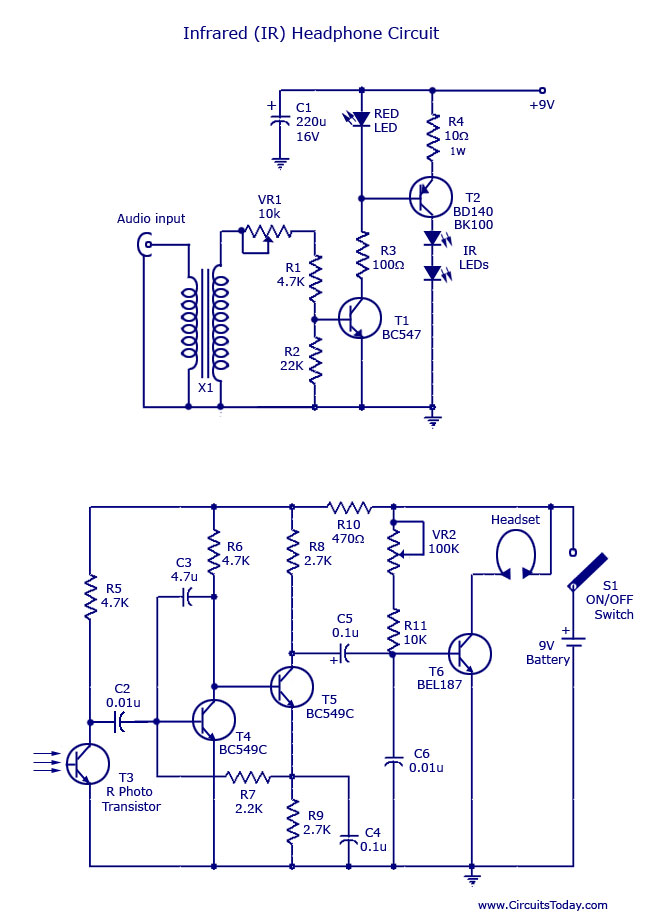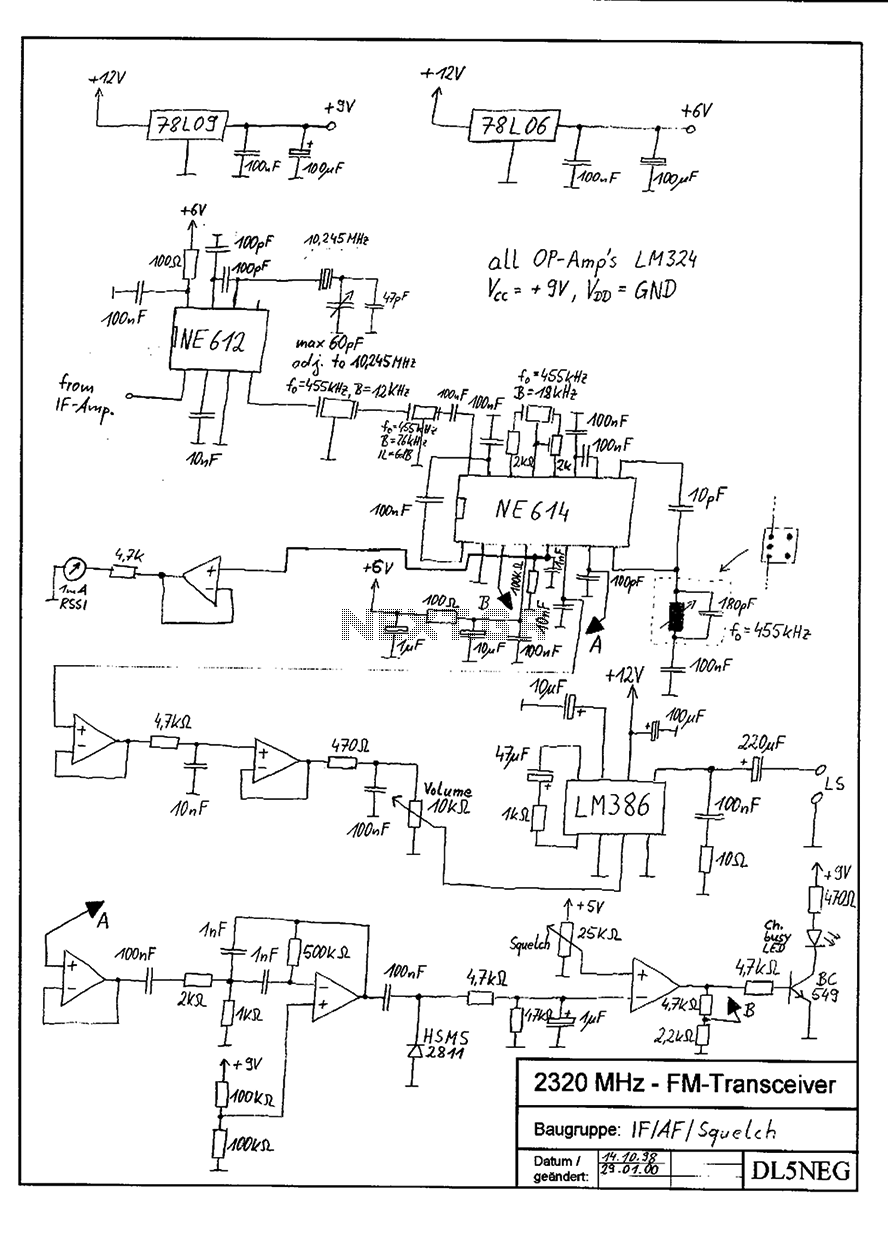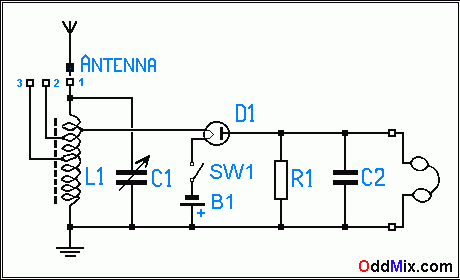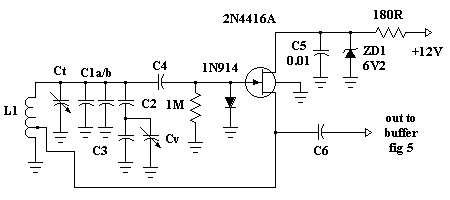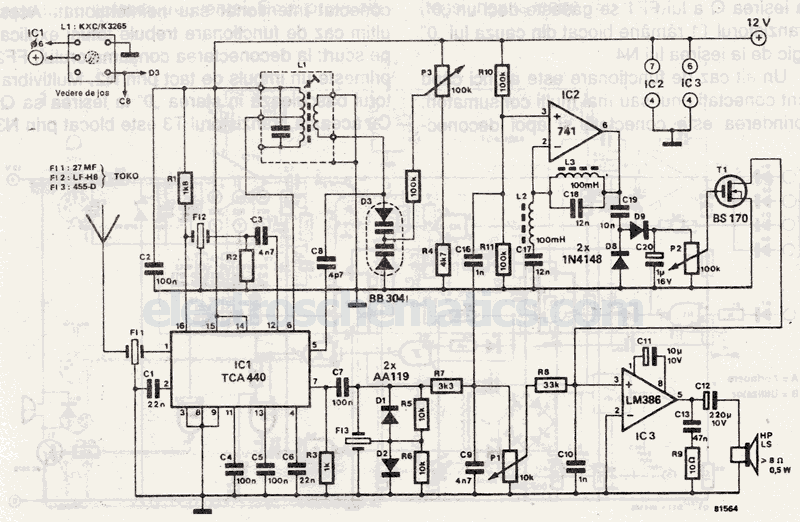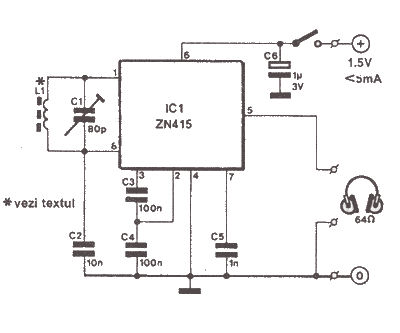
9V FM Radio Transmitter
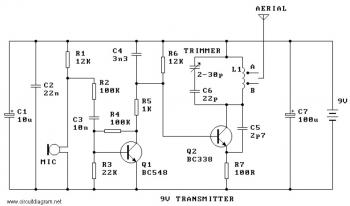
This is a simple and low-cost FM transmitter circuit. The frequency range of this FM transmitter is approximately 89 MHz to 109 MHz, with an output power of about 9 mW at 9 V. The circuit includes the following components: R1 (12K), R2 (100K), R3 (22K), R4 (100K), R5 (1K), R6 (100R), Q1 (BC338), Q2 (BC548B), and a microphone (ECM-60P). Capacitors include C1 (10uF/25V), C2 (22n), C3 (10n), C4 (3n3), C5 (2p7), C6 (22p), and C7 (100uF/16V). The tuning capacitor varies from 0 to 30 pF. This is an economical and easy-to-build low-powered FM transmitter with a claimed range of about 300 feet when powered by a 9V supply, which increases to approximately 400 feet at 12V. It is important to note that this transmitter should not be used for illegal broadcasting. The circuit employs four radio frequency stages: a VHF oscillator utilizing the BF494 transistor (T1), a preamplifier using the BF200 transistor (T2), a driver stage with the 2N2219 transistor (T3), and a power amplifier based on the 2N3866 transistor (T4). A condenser microphone is connected at the input. The following diagram illustrates the FM transmitter circuit capable of transmitting up to 4W. The voltage supply for this circuit ranges from 12V to 16V, with a current consumption of 100-400mA. This circuit operates within the emission frequency range of 88-108 MHz. The components list includes: R1, R2 = 10K Ohm (1/4 W), R3 = 47 Ohm (1/4 W), C1, C2 = 1nF.
The FM transmitter circuit described is designed to operate efficiently within the FM broadcast band, utilizing standard electronic components to achieve its functionality. The circuit is structured to provide a clear and stable transmission over the specified range, making it suitable for various applications, including hobbyist projects or educational demonstrations.
In the circuit, the BF494 transistor serves as the VHF oscillator, generating the radio frequency signal. The BF200 preamplifier amplifies the weak audio signal from the microphone before it is further processed. The 2N2219 transistor acts as a driver, boosting the signal strength before it reaches the power amplifier stage, which is built around the 2N3866 transistor. This stage is responsible for providing the necessary power to transmit the signal over a distance.
The use of a condenser microphone ensures that the audio input is captured with high fidelity, while the tuning capacitor allows for fine adjustments to the frequency, ensuring compliance with the desired transmission specifications. The inclusion of various capacitors helps filter and stabilize the circuit, contributing to improved performance and signal clarity.
Overall, this FM transmitter circuit exemplifies a straightforward approach to creating a low-power broadcasting solution, suitable for experimentation and learning in the field of electronics. The component selection and circuit design facilitate ease of assembly, making it accessible for individuals with basic electronic skills.Here the simple and low cost FM transmitter circuit. The frequency range of this FM transmitter should be about 89MHz 109MHz. Output power is about 9mW at 9V. R1, R6_12K R2, R4_100K R3_22K R5_1K R7_100R Q1_BC338 Q2_BC548B Microphone JinIn ECM-60P B1 C1_10uF/25V C2_22n C3_10n C4_3n3 C5_2p7 C6_22p C7_100uF/16V tuning capacitor_0-30pF This is a low cost and easy build low powered FM transmitter. The range of the FM transmitter claimed about 300 feets when running at 9V supply. And the range claimed to be increased become about 400 feet when running it at 12V supply. Take a note that this transmitter should not be used as. This is the FM transmitter circuit which apply 4 radio frequency stages, that are a VHF oscillator designed around transistor BF494 (T1), a preamplifier designed around transistor BF200 (T2), a driver designed around transistor 2N2219 (T3) and also a power amplifier designed around transistor 2N3866 (T4). A condenser microphone is wired at the input of. The following diagram is the FM transmitter circuit with FM transmision up to 4W. Voltage supply for this circuit is 12-16V with current consumption of 100-400mA. This circuit works with frequency of emission range of 88-108MHz. Components List: R1, R2 = 10K Ohm (1/4 W) R3 = 47 Ohm (1/4 W) C1, C2 = 1nF. Easy FM tracking transmitter project :). The circuit designed by Tony van Roon, and here the FM tracking transmitter diagram: Components List: R1 = 10K C1 = 100uF/10V C2 = 10nF C3 = 4-40pF trimmer capacitor C4 = 4.
7pF IC1 = LM3909 Q1 = 2N3904 NPN transistor LED1 = Red LED/or another color as you. 🔗 External reference
The FM transmitter circuit described is designed to operate efficiently within the FM broadcast band, utilizing standard electronic components to achieve its functionality. The circuit is structured to provide a clear and stable transmission over the specified range, making it suitable for various applications, including hobbyist projects or educational demonstrations.
In the circuit, the BF494 transistor serves as the VHF oscillator, generating the radio frequency signal. The BF200 preamplifier amplifies the weak audio signal from the microphone before it is further processed. The 2N2219 transistor acts as a driver, boosting the signal strength before it reaches the power amplifier stage, which is built around the 2N3866 transistor. This stage is responsible for providing the necessary power to transmit the signal over a distance.
The use of a condenser microphone ensures that the audio input is captured with high fidelity, while the tuning capacitor allows for fine adjustments to the frequency, ensuring compliance with the desired transmission specifications. The inclusion of various capacitors helps filter and stabilize the circuit, contributing to improved performance and signal clarity.
Overall, this FM transmitter circuit exemplifies a straightforward approach to creating a low-power broadcasting solution, suitable for experimentation and learning in the field of electronics. The component selection and circuit design facilitate ease of assembly, making it accessible for individuals with basic electronic skills.Here the simple and low cost FM transmitter circuit. The frequency range of this FM transmitter should be about 89MHz 109MHz. Output power is about 9mW at 9V. R1, R6_12K R2, R4_100K R3_22K R5_1K R7_100R Q1_BC338 Q2_BC548B Microphone JinIn ECM-60P B1 C1_10uF/25V C2_22n C3_10n C4_3n3 C5_2p7 C6_22p C7_100uF/16V tuning capacitor_0-30pF This is a low cost and easy build low powered FM transmitter. The range of the FM transmitter claimed about 300 feets when running at 9V supply. And the range claimed to be increased become about 400 feet when running it at 12V supply. Take a note that this transmitter should not be used as. This is the FM transmitter circuit which apply 4 radio frequency stages, that are a VHF oscillator designed around transistor BF494 (T1), a preamplifier designed around transistor BF200 (T2), a driver designed around transistor 2N2219 (T3) and also a power amplifier designed around transistor 2N3866 (T4). A condenser microphone is wired at the input of. The following diagram is the FM transmitter circuit with FM transmision up to 4W. Voltage supply for this circuit is 12-16V with current consumption of 100-400mA. This circuit works with frequency of emission range of 88-108MHz. Components List: R1, R2 = 10K Ohm (1/4 W) R3 = 47 Ohm (1/4 W) C1, C2 = 1nF. Easy FM tracking transmitter project :). The circuit designed by Tony van Roon, and here the FM tracking transmitter diagram: Components List: R1 = 10K C1 = 100uF/10V C2 = 10nF C3 = 4-40pF trimmer capacitor C4 = 4.
7pF IC1 = LM3909 Q1 = 2N3904 NPN transistor LED1 = Red LED/or another color as you. 🔗 External reference
